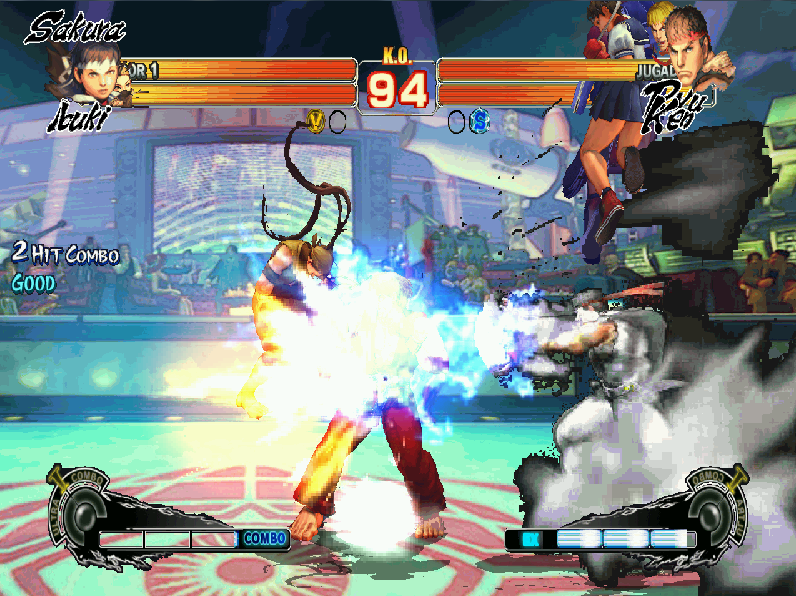
will Power Charge until the opponent gets close enough or attempts to attack, upon which it will either block the oncoming attack or counterattack attempting a jump-in will often result in the A.I. will often fire off Hadou Kens from afar, or either run or Super Jump towards the opponent depending on what they do, though if enough space exists between Ryu and the opponent, the A.I. will often only pull off simple combos upon a hit confirm and simply punish the opponent's mistakes with a raw Hyper. that scales with M.U.G.E.N's built-in difficulty setting, which affects how often it performs certain attacks, how it uses its attacks and how reliably it blocks regardless of the difficulty level, the A.I. Ryu has a moveset that covers most, if not all, scenarios, featuring an anti-air that doubles-up as a reversal, a projectile for zoning, keepaway and pressure, and an approach option in the form of Tatsumaki Senpuu Kyaku, allowing him to be played in a variety of ways to suit any situation befitting of this, Ryu doesn't necessarily excel at any particular playstyle, though his variety of options and aforementioned agility allow him to quickly overcome characters if they are unable to outrange him or counter his movements before he gets close. Ryu is a very quick character in terms of both attacks and mobility, with the majority of his attacks leaving him at a positive frame advantage or simply creating enough distance between himself and the opponent for them to be unable to counter-attack, thus making it very difficult for the opponent to punish him. Capcom series, activated by pressing followed by either, , or, though it acts as a movement option instead of a way to chase the opponent for an aerial rave.


In addition to his Low Jump, which causes Ryu to jump at a much lower height than a regular jump by tapping instead of fully pressing it, Ryu also features the Super Jump (named High Jump) from the Marvel vs. Taken from the S Groove is the Power Charge, which allows Ryu to gradually build up Power by holding Ⓑ + Ⓨ, with the speed at which Power is gained increasing while the Power Charge is active this works well in conjunction with the A Groove's Custom Combo mode (named Excel Combo), which costs 1000 Power and grants Ryu the ability to freely cancel and juggle any Normal or Special for a total of 3 seconds, but disables blocking, natural Power gain, Parry High, Parry Low, Air Parry, Power Charge, EX Specials and Hypers, with the mode ending abruptly should Ryu get hit. SNK 2's Grooves, Ryu borrows the majority of his mechanics from the C Groove, using the standard three-tiered powerbar (3000 Power) and a modified version of said Groove's Super Combo Cancel sub-system that allows Hypers to cancel into other Hypers as long as enough Power is available, with the exception of Shinkuu Hadou Ken being unable to cancel into Denjin Hadou Ken and the latter being unable to cancel into anything at all, offset by its dizzying property. By pressing or in conjunction with either or, Ryu will attempt to grab the opponent, though even if the grab is successful, the opponent can grab escape by pressing Ⓑ, Ⓒ, Ⓨ, or Ⓩ and either or just as Ryu connects with the grab although all of Ryu's grabs function the same on a fundamental level, the Ⓧ + Ⓨ grab is slightly different in that it slams the opponent to the ground directly in front of Ryu and deals slightly more damage.ĭespite using elements taken from each of Capcom vs. SNK 2 subsequently used, wherein Normals can be cancelled into Specials and Hypers, Specials can be cancelled into Hypers, and Hypers can be cancelled into other Hypers, though the timing is often very strict.

Ryu follows the traditional Street Fighter combo system that Capcom vs. A seventh button ( Ⓢ ) is used as part of the activation for Hadou no Kamae, a feint where Ryu pretends to launch a Hadou Ken. Ryu is a standard six-button character with three kick buttons and three punch buttons, respectively assigned to and, that denote the strength of the Normal Attack associated with it, with Ⓐ and Ⓧ being the weaker, less punishable Normals, and Ⓒ and Ⓩ being the stronger, more punishable Normals certain Specials also follow this rule, such as the Shoryuu Ken, in that the stronger versions are more punishable in comparison to the weaker versions due to the increased vertical distance.


 0 kommentar(er)
0 kommentar(er)
